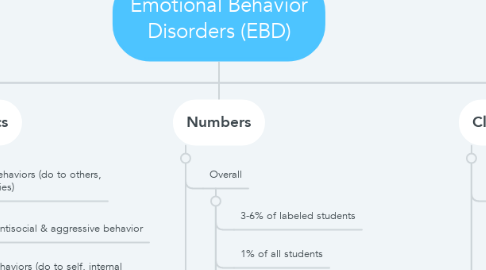
1. IDEIA Definition
1.1. 1+ of following characteristics over long period of time to marked degree that adversely affects edu performance
1.1.1. Inability to learn (can’t be explained by intellectual, sensory, health factors)
1.1.2. Inability to build or maintain interpersonal relationships
1.1.3. Inappropriate behaviors in social situations
1.1.4. Pervasive mood of unhappiness or depression
1.1.5. Tendency to develop physical symptoms or fears associated w/ personal or school probs
1.2. Includes schizophrenia but not those who are socially maladjusted
1.2.1. Socially maladjusted - conscious decisions, understand consequences
1.2.2. w/ ED - acting w/o forethought (can’t control), not aware of consequences
2. Classroom Management
2.1. Teacher praise (reinforcement) = key part of PBS
2.1.1. Praise when something is done correctly
2.1.2. Ignoring behaviors that are not distracting to other students or not helpful for their own learning
2.2. High rates of active student response (ASR)
2.2.1. Keep students involved
2.2.2. Know which way student needs it (call on student before asking question, ask question before asking a specific student)
2.3. Explicit instructional pracs, including direct instruction
2.3.1. Narrow parameters are better than having a bunch of rules
2.3.2. Set up clear expectations (define & explain)
2.3.3. Consistent
2.4. Schoolwide positive behavior support (SWPBS), functional assessment-based individual plans, self-management
2.5. Stay in control (esp of yourself)
2.5.1. Let students see your failure & frustration
2.5.2. Apologize for mistakes (I’m sorry with no “but” - no blaming)
2.6. Keep & use your sense of humor
2.6.1. Laugh at yourself every once in a while
2.6.2. Create a sunshine folders (collect positive thoughts about each students)
3. Numbers
3.1. Overall
3.1.1. 3-6% of labeled students
3.1.2. 1% of all students
3.1.3. 75% are boys (usually identified more easily)
3.1.4. Only 35% grad from high school (76% gen ed)
3.1.5. 75% of those who drop out are arrested w/in 5 yrs of dropping out
3.1.6. 85% incarcerated juveniles have been identified w/ some kind of disability (LD & EBD are largest groups)
3.2. Of this population
3.2.1. 39% in gen ed
3.2.2. 19% in resource room
3.2.3. 23% in separate classroom
3.2.4. 13% in special schools
3.2.5. 2% in correctional facilities
3.2.6. 2% in residential facilities
3.2.7. 1% in home (usually a single parent) or hospital (usually a mental hospital)
4. Characteristics
4.1. Externalizing behaviors (do to others, outside of bodies)
4.1.1. Exhibit antisocial & aggressive behavior
4.2. Internalizing behaviors (do to self, internal thoughts)
4.2.1. Withdrawn & lack social skills
4.3. Academic achievement generally low
4.3.1. Perform academically 1+ yrs below grade level
4.4. Often have LD or lang delays
4.5. Often have score below average on IQ tests (still w/in normal ranges)
5. Etiology
5.1. Environmental
5.1.1. Culture
5.1.2. Familial unit
5.1.2.1. Way & type of discipline used in home (lack of clarity
5.1.2.2. Violence in home
5.1.2.3. Neglect, trauma
5.1.3. School
5.1.3.1. Non accepting environment → less social & emotional growth
5.1.3.2. Importance of encouragement & consistency
5.2. Organic (rare)
5.2.1. Dysfunctions of central nervous system (meningitis, encephalitis)
5.2.2. Brain disorders (abnormal development, injury - disease or trauma)
5.3. Genetic
5.3.1. Strongest link - family history of schizophrenia
5.4. Temperament
5.4.1. Way one responds to situation (inborn biological influence)
5.4.2. Infant - distractible, frequently fusses, w/draws from new situations, difficult temperament
5.5. Tourette’s Syndrome
5.5.1. Involuntary motor movements, often in rapid succession
5.5.2. Sudden onset
5.5.3. Vocal tics often include involuntary repetition of obscenities
